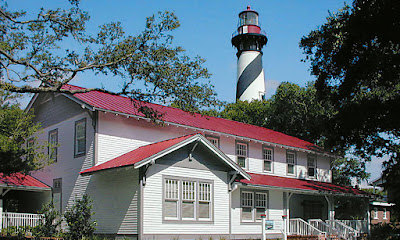*Originally published June 22, 2021 as a promotional piece. Some information is missing.
When people ask me where I think the best places in Florida are, St. Augustine is always at the top of my list. The city is filled with history, family friendly, pet friendly, and packed with award-winning museums and restaurants. The Ximenez-Fatio House, which managed a ranking of the number one museum in St. Augustine during the pandemic of 2020, is no exception.
Don Andres Ximenez built the house and warehouse in 1798 for himself and his bride, Juana Pellicer Ximenez. Juana's father, Francisco Pellicer, led the Minorcans from New Smyrna to St. Augustine in 1777 at the invitation of British governor Colonel Patrick Tonyn. This is the same group of Minorcans I've previously mentioned who fled their captivity as slaves of Dr. Andrew Turnbull. Pellicer brought about 600 people to St. Augustine, and they settled at the north end of St. George Street near the City Gate.
In his original plan for the location, Ximenez included a grocery store and storage room, tavern, and billiard hall on the first floor; family living space and bedrooms on the second floor; and quarters for the servants and slaves on the third floor. There were also two large warehouses on the first floor, now known to us as the first floor guest rooms, as well as a detached kitchen and washroom.
Sadly, Juana died in 1802, shortly after the home's construction, and Andres followed a few years later in 1806. She was jut 26, and he was 53.
The remaining Ximenez family passed the property among themselves until 1825, when Mrs. Margaret Cook and her husband purchased a 1/3 interest in the house. She bought another 1/3 interest when her husband passed away in 1827, and by 1830, Mrs. Cook owned the entire property.
She converted the home into a boarding house, converting the tavern into a lobby and the billiard hall into a dining room. It was she who converted the two warehouses into the downstairs guest rooms. She allowed the grocery store and storeroom to remain intact because they were so profitable.
Mrs. Cook hired Eliza Whitehurst (a single woman) to manage the boardinghouse, but Miss Whitehurst unfortunately died in June 1830 due to the epidemic of Yellow Fever.
In July 1830, Sarah Petty Anderson (a single woman) bought the boarding house from Mrs. Cook. She managed it herself until she hired Louisa Fatio (also a single woman) to handle the management tasks for her in 1852, later selling the boarding house to Miss Fatio in 1855 and moving to Tallahassee.
Miss Fatio owned and maintained the property for years, keeping it afloat through times of slavery, secession from the Union, war, re-occupation by Union Troops in 1862, and then Reconstruction.
She died in 1875, having maintained the prominence, good reputation, and integtrity of this boarding house through a period of history when single women rarely owned businesses and the term boarding house" often had a negative implication.
After Miss Fatio's death, the house spent the next several decades as an artist's retreat until it fell into disrepair in the 1930s. The grocery store and storeroom, however, always housed a retail business of some sort through this time.
In 1939, the National Society of the Colonial Dames of America in the State of Florida purchased the property, fixed it up, and reopened it to the public in May of 1940 as an example of historic home renovation.
The coquina rock house and detached kitchen have been restored without replacing any of the original building materials. All of the furnishings and artifacts have been researched for accuracy. As a result, the Ximenez-Fatio House is considered the most authientic 18th century building in St. Augustine.
The tour guides are experts on an era when the small, secluded town of St. Augustine became a tourist destination almost overnight.
The house has been owned and managed by women since the 1830s, a time when it was rare for women to own property, own a business, or earn a paycheck. By using their household management skills to earn a living, they basically set up the standards for modern tourism, which is the backbone of Florida's current economy.
This is one of the few historic properties owned and operated by a private non-profit organization. After almost 200 years, the property is still owned and managed by women.
The historic detached kitchen, shown above, contains an original 1800s beehive oven, believed to be one of three still surviving in Florida. In its day it would have been an indispensible tool, feeding many guests three times a day. Its fire would have burned all night in order to ensure that baking could begin at dawn.
The restoration of the house lasted decades. For approximately 75 years, some of America's top historians, archaeologists, and architects have guided the restoration and interpretation of this museum. The extraordinary attention to detail and personal care given in every step create an exceptional intimate connection with the past, making the property uniquely engaging and fascinating. TripAdvisor consistently ranks the museum among the top St. Augustine attractions every year.
After Florida became part of the United States, St. Augustine became a tourist destination, and a location where doctors often recommended that people with certain respiratory illnesses could seek relief. There was also a large military presence at the US occupied Castillo de San Marcos.
The Ximenez-Fatio House was one of the largest boarding houses in the city. Several additions were made in later years to increase the number of rooms.
As an upscale inn, it hosted individuals, families, politicians, sea captains, soldiers, and adventurers.
Owned and operated by a succession of hard-working and intelligent women, the boarding house was a highly regarded place to stay in St. Augustine in its day.
Check out their website for information regarding daily tour offerings, "Heist at the Museum" events, ghost and paranormal experience tours, and details for booking weddings, receptions, and other events.
20 Aviles Street
St. Augustine, FL 32084
904-829-3575
Do you have any information or personal experiences to share about this entry? Let us know in the comments, and your contribution could be included in a future update to this entry!
























































